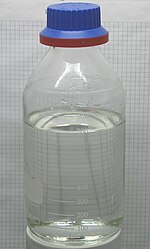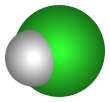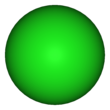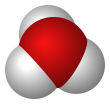ഹൈഡ്രോക്ലോറിക് അമ്ലം
ദൃശ്യരൂപം
| |||
| |||

| |||
| Names | |||
|---|---|---|---|
| IUPAC name
Chlorane[3]
| |||
| Other names | |||
| Identifiers | |||
| ChEMBL | |||
| ChemSpider | |||
| ECHA InfoCard | 100.210.665 | ||
| EC Number |
| ||
| E number | E507 (acidity regulators, ...) | ||
PubChem CID
|
|||
| UNII | |||
| UN number | 1789 | ||
| Properties | |||
| HCl(aq) | |||
| Appearance | Colorless, transparent liquid, fumes in air if concentrated | ||
| Odor | Pungent characteristic | ||
| ദ്രവണാങ്കം | |||
| ക്വഥനാങ്കം | Concentration-dependent – see table | ||
| log P | 0.00[4] | ||
| Acidity (pKa) | −5.9 (HCl gas)[5] | ||
| Hazards | |||
| GHS labelling: | |||
 
| |||
| Danger[6] | |||
| H290, H314, H335[6] | |||
| P260, P280, P303+361+353, P305+351+338[6] | |||
| NFPA 704 (fire diamond) | |||
Except where otherwise noted, data are given for materials in their standard state (at 25 °C [77 °F], 100 kPa).
| |||
ഹൈഡ്രജൻ ക്ലോറൈഡിൻറെ ജലീയ ലായനിയാണ് ഹൈഡ്രോക്ലോറിക് അമ്ലം. ഇത് ശക്തിയേറിയ ധാതു അമ്ലമാണ്.
ചരിത്രം
[തിരുത്തുക]800-ആമാണ്ടിൽ ആൽകെമിസ്റ്റ് ജാബിർ ഇബ്ൻ ഹയാൻ ആണ് ഹൈഡ്രോക്ലോറിക് അമ്ലം ആദ്യമായി കണ്ടുപിടിച്ചത്. സോഡിയം ക്ലോറൈഡും സൾഫ്യൂരിക് അമ്ലവും കലർത്തിയാണ് അന്ന് ഇത് നിർമ്മിച്ചത്[7][8].
നൈട്രിക് ആസിഡിൽ സാൽ അമോണിയാക്ക് ലയിപ്പിച്ച് തയ്യാറാക്കിയ ഹൈഡ്രോക്ലോറിക്, നൈട്രിക് ആസിഡുകൾ അടങ്ങിയ അക്വാ റീജിയ, പതിമൂന്നാം നൂറ്റാണ്ടിലെ യൂറോപ്യൻ ആൽക്കെമിസ്റ്റായ സ്യൂഡോ-ഗെബറിന്റെ കൃതികളിൽ വിവരിച്ചിട്ടുണ്ട്[9][10][11][12][13]. പതിമൂന്നാം നൂറ്റാണ്ടിന്റെ അവസാനത്തിലെ ബൈസന്റൈൻ കൈയെഴുത്തുപ്രതികളിലാണ് അക്വാ റീജിയയെക്കുറിച്ചുള്ള ആദ്യത്തെ പരാമർശം എന്നാണ് മറ്റ് പരാമർശങ്ങൾ സൂചിപ്പിക്കുന്നത്[14][15][16][17].
ഭൗതിക ഗുണങ്ങൾ
[തിരുത്തുക]| Concentration | Density | Molarity | pH | Viscosity | Specific heat |
Vapour pressure |
Boiling point |
Melting point | ||
|---|---|---|---|---|---|---|---|---|---|---|
| kg HCl/kg | kg HCl/m3 | Baumé | kg/L | mol/L | mPa·s | kJ/(kg·K) | kPa | °C | °C | |
| 10% | 104.80 | 6.6 | 1.048 | 2.87 | −0.5 | 1.16 | 3.47 | 1.95 | 103 | −18 |
| 20% | 219.60 | 13 | 1.098 | 6.02 | −0.8 | 1.37 | 2.99 | 1.40 | 108 | −59 |
| 30% | 344.70 | 19 | 1.149 | 9.45 | −1.0 | 1.70 | 2.60 | 2.13 | 90 | −52 |
| 32% | 370.88 | 20 | 1.159 | 10.17 | −1.0 | 1.80 | 2.55 | 3.73 | 84 | −43 |
| 34% | 397.46 | 21 | 1.169 | 10.90 | −1.0 | 1.90 | 2.50 | 7.24 | 71 | −36 |
| 36% | 424.44 | 22 | 1.179 | 11.64 | −1.1 | 1.99 | 2.46 | 14.5 | 61 | −30 |
| 38% | 451.82 | 23 | 1.189 | 12.39 | −1.1 | 2.10 | 2.43 | 28.3 | 48 | −26 |
| The reference temperature and pressure for the above table are 20 °C and 1 atmosphere (101.325 kPa). Vapour pressure values are taken from the International Critical Tables and refer to the total vapour pressure of the solution. | ||||||||||

അവലംബം
[തിരുത്തുക]- ↑ ഉദ്ധരിച്ചതിൽ പിഴവ്: അസാധുവായ
<ref>ടാഗ്;muriatic_acidഎന്ന പേരിലെ അവലംബങ്ങൾക്ക് എഴുത്തൊന്നും നൽകിയിട്ടില്ല. - ↑ "spirits of salt". Retrieved 29 May 2012.
- ↑ Henri A. Favre; Warren H. Powell, eds. (2014). Nomenclature of Organic Chemistry: IUPAC Recommendations and Preferred Names 2013. Cambridge: The Royal Society of Chemistry. p. 131.
- ↑ "Hydrochloric acid". www.chemsrc.com.
- ↑ Trummal, Aleksander; Lipping, Lauri; Kaljurand, Ivari; Koppel, Ilmar A.; Leito, Ivo (2016-05-06). "Acidity of Strong Acids in Water and Dimethyl Sulfoxide". The Journal of Physical Chemistry A (in ഇംഗ്ലീഷ്). 120 (20): 3663–3669. Bibcode:2016JPCA..120.3663T. doi:10.1021/acs.jpca.6b02253. ISSN 1089-5639. PMID 27115918.
- ↑ 6.0 6.1 6.2 Sigma-Aldrich Co., Hydrochloric acid. Retrieved on 2017-11-29.
- ↑ Van Dorst, W.C.A. (2004). Technical product brochure Hydrochloric Acid (public document ed.). Amersfoort: Akzo Nobel Base Chemicals.
{{cite book}}: Unknown parameter|coauthors=ignored (|author=suggested) (help) - ↑ Leicester, Henry Marshall (1971). The historical background of chemistry. New York: Dover Publications. ISBN 0-486-61053-5.
- ↑ Bauer, Hugo (2009). A history of chemistry. BiblioBazaar, LLC. p. 31. ISBN 978-1-103-35786-4.
- ↑ Karpenko, V.; Norris, J.A. (2001). "Vitriol in the history of chemistry" (PDF). Chem. Listy. 96: 997.
- ↑ "Hydrochloric Acid". Chemicals Economics Handbook. SRI International. 2001. pp. 733.4000A–733.3003F.
- ↑ Norton, S. (2008). "A Brief History of Potable Gold". Molecular Interventions. 8 (3): 120–3. doi:10.1124/mi.8.3.1. PMID 18693188. Archived from the original on 2020-04-06. Retrieved 2019-12-20.
- ↑ Thompson, C. J. S. (2002). Alchemy and Alchemists (Reprint of the edition published by George G. Harrap and Co., London, 1932 ed.). Mineola, NY: Dover Publications. pp. 61, 18.
- ↑ ഉദ്ധരിച്ചതിൽ പിഴവ്: അസാധുവായ
<ref>ടാഗ്;Forbes1970എന്ന പേരിലെ അവലംബങ്ങൾക്ക് എഴുത്തൊന്നും നൽകിയിട്ടില്ല. - ↑ Myers, R. L. (2007). The 100 most important chemical compounds: a reference guide. Greenwood Publishing Group. p. 141. ISBN 978-0-313-33758-1.
- ↑ Datta, N. C. (2005). The story of chemistry. Universities Press. p. 40. ISBN 978-81-7371-530-3.
- ↑ Pereira, Jonathan (1854). The elements of materia medica and therapeutics, Volume 1. Longman, Brown, Green, and Longmans. p. 387.
- ↑ "Systemnummer 6 Chlor". Gmelins Handbuch der Anorganischen Chemie. Chemie Berlin. 1927.
- ↑ "Systemnummer 6 Chlor, Ergänzungsband Teil B – Lieferung 1". Gmelins Handbuch der Anorganischen Chemie. Chemie Weinheim. 1968.
പുറം കണ്ണികൾ
[തിരുത്തുക]- General safety information
- EPA Hazard Summary
- Hydrochloric acid MSDS by American Bioanalytical
- Hydrochloric acid MSDS by Georgia Institute of Technology Archived 2003-08-18 at the Wayback Machine
- Pollution information





